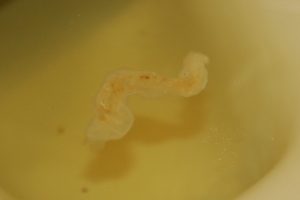During menstrual cycle as we have discussed in the previous articles that ovulation takes place somewhere around the day fourteen of the cycle. Any intercourse made during this fertile phase is likely to cause pregnancy, the phase during which egg is viable inside the female reproductive tract, the phase is known as fertile phase. If fertilization occurs (i.e., the union of egg and sperm), the zygote will be formed (the fertilized egg), the zygote initially remains inside the fallopian tube and undergoes complex cell divisions and is later in sent to uterus where it will embed itself in the muscular and highly vascularised uterine walls. The process in which the fertilized egg embeds itself in the uterine walls is known as implantation. The fertilized egg for implantation sinks from fallopian tube into the uterus and this happens 10 to 12 days following fertilization.
When ovulation occurs, the ovary releases the egg. The egg remains viable inside a female reproductive tract for 2 to 3 days inside the fallopian tube. The combination of sperm and egg is known as fertilization and the process results in the formation of zygote (a single celled structure). The zygote formed then starts undergoing rapid cell divisions and at this phase the zygote multiplies itself into 2, 4, 8 and so on. Such quick cell divisions result in the multi-celled structure known as blastocyst. The blastocyst enters the uterus a week after fertilization.
Blastocyst is a tiny cells cluster which is too small in size; the size is comparable to the pin head. At the day of implantation many females feel no specific symptoms. While in some females, there is some occasional bleeding or spotting at the time when implantation of blastocyst occurs. The implantation bleeding normally occurs in brown color while in some females it might be fresh blood and is of red color. In some cases, few drops of blood are also seen at the undergarments and while it has been reported by some females that they have lost substantial blood. Any bleeding which is similar to menstrual flow there is less chance of linking it to implantation bleeding.
Recommended Reading :
- Pinkish Brown discharge Spotting while on birth control
- Concerns regarding thick white discharge before period
Contents
Implantation Bleeding Color:
The implantation bleeding color and flow both are important to consider while female is suspecting her pregnancy. The implantation bleeding color is mostly brownish but sometimes it can look like a reddish blood. In menstruation, the bleeding in the start is light and turns massive few hours later, while the implantation bleeding color is brown with no blood clots as one is likely to see during menstruation. If you are getting heavy bleeding it cannot be linked with pregnancy as bleeding which occurs during pregnancy is generally light, however if a female is experiencing heavy bleeding, she is likely to have a miscarriage. Implantation bleeding duration is also variable in different females; it might take few hours to a day. Most of the females wonder, what does implantation bleeding look like on a pad? The simple answer to it is the brown to brownish red color blood with no clots. If you are getting Implantation bleeding pregnancy test can be taken and this is a time when you are likely to get positive result. Brown implantation bleeding is common in females and is not a reason to worry. But one of the biggest questions as we have seen from pregnant females is, can implantation bleeding be red? Well, yes. I some cases the implantation bleeding can look like few fresh drops of blood but it is very slight and rare as well. Also the implantation bleeding timings are important. The implantation bleeding might take few hours like 2-3 hours to almost a day or so. Read more info Most Common std
What Color Does Implantation Bleeding Color Look Like?
Any bleeding which is somewhat between brown to pink in color is an indicator of implantation. The bleeding if it is massive and red in color generally indicates periods. There are fewer cases where one gets red color implantation bleeding. The indication is that while the embryo is embedding itself, it has just shed some blood from the linings of uterus.
Implantation Bleeding Symptoms:
There is some prominent implantation bleeding symptoms as reported by pregnant females. The symptoms include:
- Spotting or brownish to pink discharge
- Little cramping which causes slight disturbance.
- Headaches and mood swings due to hormonal misbalance
One of trickiest things here is that implantation bleeding and cramping can be early signs of pregnancy. Besides, breast tenderness sometimes is often reported to be linked with pregnancy and is considered as one of the important early indicators of pregnancy. Implantation bleeding heavy is rare, it is mostly a little to a moderate bleed. Implantation bleeding symptoms are mostly common in pregnant females. Hence if you are getting brownish discharge along with mild cramps it might be early Implantation bleeding symptoms.

When Does Implantation Bleeding Happen?
Implantation bleeding takes place as embryo embeds itself in the walls of uterus, as it happens, a little blood is shed which causes implantation bleeding.
Chemical pregnancy symptoms:
Sometimes while suspecting pregnancy females get positive pregnancy test while the time thay visit the doctor, they miscarry before doctor is able to visualize the gestation sac or any blastocyst at ultrasound. The only evidence of such pregnancy is the positive test result on pregnancy strip hence it is termed as a chemical pregnancy. This is caused when fertilized egg due to some underlying reasons fail to grow or embed itself in the walls of uterus. The females often experience the typical four weeks pregnancy symptoms as well.
Implantation Signs:
The very early Implantation signs which are reported along with bleeding include:
- Slight to moderate spotting
- Minor cramping or lower abdominal discomfort.
Cramping is felt in some females as the blastocyst attaches itself in the walls of uterus. These cramps are mild and are much lighter as compared to menstrual cramping. As a sign of implantation cramping is to be kept under consideration by the females. The implantation signs also include mood swings which are caused by changes in hormones inside the body. The successful implantation symptoms are nausea, sensitivity to smell, vomiting, fatigue etc. Implantation feeling is also reported in some females which include lower back pain and mild cramping. All the Implantation signs are needed to be recorded before consulting the health care provider. Signs of successful implantation might not be too obvious in all the females.
When Does Implantation Happen?
Implantation occurs after a week or ten days following fertilization. It is the embedding of fertilized egg inside the walls of uterus.
When Does Implantation Bleeding Happen?
An implantation bleeding is likely to happen when the fertilized egg moves down from fallopian tube into the uterus and embeds itself there. As a result of this some uterine walls are scratched and the tiny blood vessels underneath it are broken down, you might experience slight bleeding as a result which is known as implantation bleeding. The implantation bleeding takes place a week to 10 days following fertilization. Some other Implantation signs are seen along with the bleeding which is considered pregnancy markers.
Pregnancy Implantation:
When pregnancy implantation happen in the body, women normally get a feeling of being exhausted, little bit of cramping and some other symptoms like the ones seen just before the start of the periods. It is also seen that period bleeding is mistaken as implantation bleeding by some females, so in order to avoid confusions; the females need to calm down and keep a record of duration of implantation bleeding before the countdown to pregnancy begins. Pregnancy implantation takes place when the blastocyst attaches itself to the uterine walls.

How Long After Ovulation Does Implantation Happen?
Ovulation takes place on 14th day of menstrual cycle in healthy and normal females. The egg remains viable inside the uterus for 2-3days which once again is greatly dependent on the health condition of female. Implantation happens after a week to 10 days following fertilization.
Pregnancy symptoms week by week vary as the size of blastocyst increase and there is more hike in some hormones during pregnancy. Pregnancy symptoms generally appear once you have missed your periods. In some cases pregnancy symptoms before missed periods are however reported by females. Pregnancy symptoms week 1 are generally mild as there is very little hormonal change in the body. Some early signs of pregnancy are discharge and cramping in the uterus.
Implantation Bleeding and Cramping:
Implantation bleeding and cramping takes place when fertilized egg implants itself in the walls of uterus. Keeping a record of duration of implantation bleeding is very important as a female experiencing heavy bleeding during pregnancy can take all the precautions to keep the baby safe. Implantation bleeding takes place as earliest signs of conception and it can also be seen as a result of sexual intercourse with partner. It is hence essential for a female to keep a note on blood or spotting that takes place after fertilization. The duration of implantation bleeding is also different in females and there is no specific time limit for how long the implantation bleeding will last. Implantation bleeding and cramping are considered as initial pregnancy symptoms.
Implantation Cramps vs. Period Cramps:
Implantation bleeding and cramping are regarded as earliest pregnancy symptoms. Implantation bleeding and cramping are different from periods bleeding and cramping as the bleeding and cramps which takes place during periods are somewhat heavy and massive. You might need painkillers to get over period cramps and likewise the period bleeding will last from 3-5 days. On the other hand, implantation cramps feel like moderate pressure at the lower abdomen which causes you a slight discomfort.
When Does Implantation Cramp Occur?
Implantation cramps occur at the time of implantation when blastocyst finds its way to the uterus for embedding and getting nourishment from the maternal body. Implantation bleeding and cramping in majority of the cases occur at the same time.
Where Do you Feel Implantation Cramps?
Implantation cramps are felt in the lower abdomen as a slight pressure that is exerted on the uterus.
Hence to conclude all the things as mentioned in the article, implantation bleeding is something that is quite common in pregnancy and it generally is not a reason to worry. However if you are facing some other complications along with implantation bleeding like, severe cramps, reddish blood along with back pain, you must seek immediate medical attention as they might be an indication of chemical pregnancy.
Also one has to be very careful while undergoing implantation bleeding, a check of how much blood is being lost and what is the color of blood which is being discharged during implantation bleeding is important. Sometimes due to the scratching of uterine walls to embed it, the blastocyst results in shedding some cells along with damaged blood vessels which cause the appearance of blood reddish. In any case experiencing red bleeding is never a healthy sign and as a precaution you must discuss this with your health care provider.
General facts about Implantation and Implantation bleeding:
There are some key factors which are associated with implantation bleeding and it has to be kept in record.
- The discharge is much lesser as compared to period discharge
- The cramping is mild as compared to that which happens during periods.
- Brown to reddish brown discharge is normal while bright red colored discharge can indicate some problem as well.
- As the pregnancy begins and you check it via pregnancy strip or home kit, you must consult your doctor to make you and your baby well protected.
Related posts :










